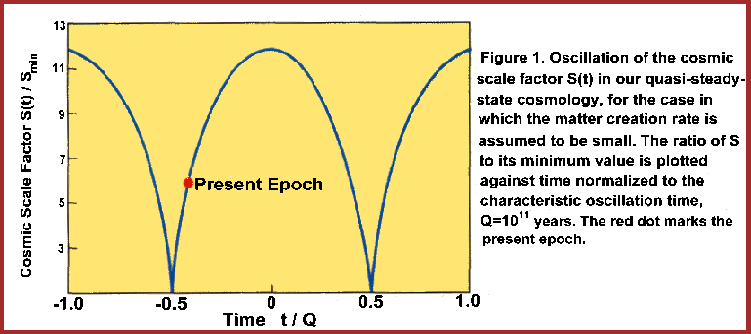
 Editor, Annual Reviews of Astronomy and Astrophysics
Editor, Annual Reviews of Astronomy and Astrophysics

 Scientific Editor, Astrophysical Journal
Scientific Editor, Astrophysical Journal

 Fellow, Royal Society
Fellow, Royal Society

 AAS Warner Prize (with M. Burbidge) 1959
AAS Warner Prize (with M. Burbidge) 1959

 NRAO Jansky Lecturer
NRAO Jansky Lecturer

 ASP
Bruce Medalist 1999
ASP
Bruce Medalist 1999

 Research Interests: Research Interests:
 Theoretical Astrophysics: Theoretical Astrophysics:
|
Physics of active galaxies and quasi-stellar objects |
| Non-thermal radiation processes |
| Cosmology |
With my collaborators, Fred Hoyle and Jayant Narlikar, I am working on the
nature of
quasi-stellar objects, the origin of the redshifts in these objects,
and on Quasi-Steady
State Cosmology, an alternative to the Big Bang theory.
The Quasi-Steady State Cosmology

The Quasi-Steady State Cosmology is an oscillatory, general-relativistic
cosmology in which matter is created in "mini-big bangs" of about
1016 M ,
occurring at intervals of ~ H0-1. In this model,
4He is produced by nucleosynthesis in stars. It is then thermalized by
dust grains at epochs near oscillatory minimum to produce the observed cosmic
microwave background radiation (CMB). The energy released in the synthesis of
cosmic 4He from hydrogen is nearly equal to the energy
contained in the CMB. This result strongly suggests that the 4He
was produced by hydrogen burning in stars and not in the early stages of a big bang.
In addition, we have shown that there are good arguments for believing that
the other light isotopes, D,
3He, 6Li, 7Li, 9Be,
10B, and 11B, were also
synthesized in processes within stars. By combining these results with
the earlier, much more detailed work of Burbidge et al. and of Cameron, we
conclude that all of the chemical elements were
synthesized from hydrogen in stars over a time of about
1011 yr. ,
occurring at intervals of ~ H0-1. In this model,
4He is produced by nucleosynthesis in stars. It is then thermalized by
dust grains at epochs near oscillatory minimum to produce the observed cosmic
microwave background radiation (CMB). The energy released in the synthesis of
cosmic 4He from hydrogen is nearly equal to the energy
contained in the CMB. This result strongly suggests that the 4He
was produced by hydrogen burning in stars and not in the early stages of a big bang.
In addition, we have shown that there are good arguments for believing that
the other light isotopes, D,
3He, 6Li, 7Li, 9Be,
10B, and 11B, were also
synthesized in processes within stars. By combining these results with
the earlier, much more detailed work of Burbidge et al. and of Cameron, we
conclude that all of the chemical elements were
synthesized from hydrogen in stars over a time of about
1011 yr.
This cosmology is described in our article in the April 1999 Physics
Today and in several of the publications listed below.

 Selected Publications
Selected Publications

 Links: Links:
 CASS Research Interests Page
CASS Research Interests Page
 gburbidge@ucsd.edu
gburbidge@ucsd.edu
|



 Geoffrey R. Burbidge
Geoffrey R. Burbidge Professor
Professor Department of Physics
Department of Physics University of California, San Diego
University of California, San Diego  Ph.D. London 1951
Ph.D. London 1951


 Geoffrey R. Burbidge
Geoffrey R. Burbidge Professor
Professor Department of Physics
Department of Physics University of California, San Diego
University of California, San Diego  Ph.D. London 1951
Ph.D. London 1951